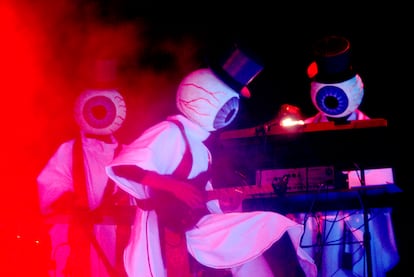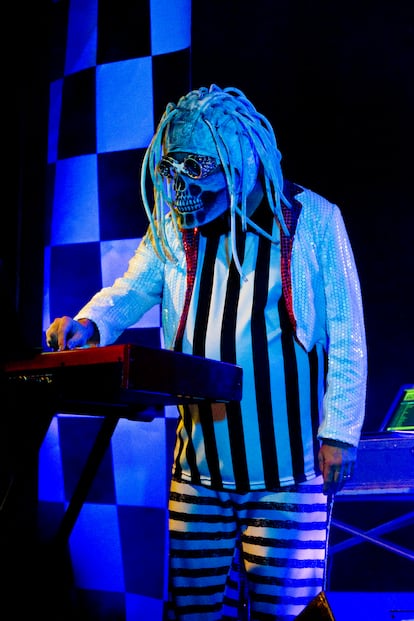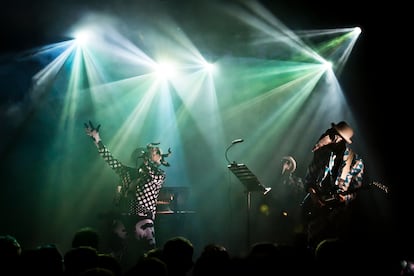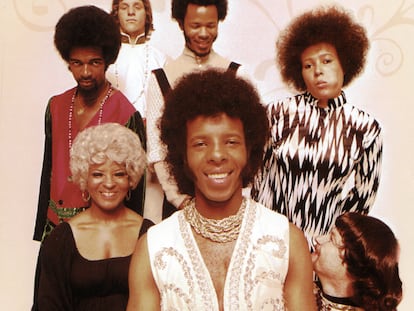The mystery of the Residents, the faceless cult band that mocked the Beatles
‘Doctor Dark,’ an opera about assisted suicide, is the latest album by the secretive group that for 50 years has been defending the idea that true art can only be achieved anonymously


The theory of obscurity argues that the author of a work should remain anonymous, to prevent the individual’s ego and the desire for recognition from corrupting the purity of the artistic act. It is said to have been formulated by a Bavarian composer named N. Senada, whose identity, of course, is in question. The mysterious N. Senada is also credited with the theory of phonetic organization, a principle for constructing music by juxtaposing single sounds, rather than melodies or harmonies.
Both theories govern the philosophy of the avant-garde The Residents, a disturbing band of artists originating, according to official accounts, from the southern United States (specifically, Shreveport, Louisiana) and based in California in the late 1960s. Their earliest activities date back to that time, and the names of those involved have remained more or less hidden in the nearly six decades that have passed since.
The group’s combined studio albums, collaborative works, soundtracks for unreleased films, and sound fiction comfortably exceeds 60. They’ve just added a new piece to the mix, Doctor Dark, a 16-track album somewhere between thrash metal and electronica presented as a “modern opera,” whose story is inspired by the trial for alleged subliminal messages in the songs of Judas Priest (here renamed The Greasy Weasels). The trial took place after two young men, aged 18 and 20, fans of the heavy metal band, agreed to commit suicide in 1985 and the former died. It was one of the most notorious episodes of the American craze known as the Satanic Panic, which led conservative sectors to regulate music and role-playing games for fear that the devil would find a way into teenage leisure time.
The title character, Dr. Anastasia Dark, is inspired by another real-life figure: Jack Kevorkian, known in the tabloid press as Dr. Death, a euthanasia and assisted-suicide advocate who was imprisoned in Michigan between 1999 and 2007 for helping nearly 130 terminally ill patients die. The Residents, being inherently impervious, don’t give interviews, though EL PAÍS spoke via email with spokesman Homer Flynn of The Cryptic Corporation, the organization responsible for the band’s public relations.
“One of the Residents saw the 1992 film Dream Deceivers shortly after its release and described the interviews with James Vance as a train wreck that he couldn’t take his eyes off,” Flynn explains.
Dream Deceivers is a documentary about the Judas Priest case, while Vance was the teenage survivor of the double suicide pact, his face horribly disfigured by the firearm he used to try to take his own life. He died three years later.

“The group found the whole incident fascinating, as well as the absurd trial, but they didn’t know how to contextualize it. Recreating the events wasn’t enough for them, so they dismissed it until [the story of] Dr. Kevorkian, along with Hardy Fox’s assisted suicide, provided the inspiration they were looking for,” he explains.
Flynn refers to the only publicly acknowledged crack in the Residents’ enigma, that of their former member Hardy Fox, president of The Cryptic Corporation for several decades, who, after retiring, confessed to being the alter ego of one of the musicians. Suffering from a brain tumor, he died in 2018.
“I suppose you could consider Doctor Dark a tribute to Hardy, but he was so instrumental in shaping the group, as well as many of its creative values, that there could never be a definitive homage. His sensitivity in combining sounds and his unique sense of arrangement will forever mark the Residents’ work,” says his colleague.
The Third Reich ‘n Roll
While the Residents’ spokesperson doesn’t offer details about the identity of the band members, he does say that “in general, they’re not cheerful types, which doesn’t mean they’re overly serious or solemn.” “After 50 years, they prefer an attitude of relative neutrality, letting the subject of a project stimulate emotions that they then amplify with their work. They still have energy,” Flynn adds.
Since their emergence, rumors have circulated about who was hiding under the illustrious eyeball-shaped helmets, their famous esthetic signature. There was speculation that it could be a secret project led by George Harrison, a grand joke to retrace his former group’s legacy on the dark side.
The cover of their debut, Meet The Residents (1974), directly mocked Meet The Beatles! (1964), while another album included a manifesto called Why The Residents Hate The Beatles. Other iconoclasts, the members of Talking Heads, have also been pointed out as possible masterminds behind the affair. Those who have collaborated, such as Black Francis (Pixies), Les Claypool (Primus), Andy Partridge (XTC), and the magician Penn Jillette, have made sure not to spill the beans or expand the legend.
“I had dinner 20 years ago with a guy who claimed to be the manager of the Residents, and all he did all night was brag about how big his penis was,” Partridge said in 2015.

The initial grand summary of information about the Residents was written by Matt Groening, creator of The Simpsons, under the title The True Story of The Residents, in a guide distributed in 1979 by their fan club. It explained that the Residents got their name after sending an anonymous demo tape to the Warner executive who signed Captain Beefheart — the band’s idol, whose music they considered themselves akin to — and that the latter returned it to the same address, with “the residents” as the recipient.
The guide also published the first images of the unreleased film Vileness Fats, an expressionist and surreal fantasy that the group spent years filming and never finished. With a sickly, nightmarish atmosphere, and homemade sets and costumes, only 37 minutes of footage have ever seen the light of day.
In Never Known Questions: Five Decades Of The Residents (2015), by British journalist Ian Shirley, perhaps the most comprehensive book on the band, close friends offer another look at their peculiar personalities in those founding years.
Guitarist Roland Sheehan, who initially participated in some songs, remembered them as creative and impulsive people who could be easily driven by anything: “I once accompanied several of them and their girlfriends to a forest. They were going to shoot a porn movie! It wasn’t a professional thing, they just decided, ‘What the hell, let’s shoot a porno.’” Like Vileness Fats, the result was never commercially distributed.
The most fascinating aspect of these origins, however, was the speed at which the Residents created an entire mythology from concepts. Their second official album, Not Available, the fourth in order of release, was based on the unavailability announced in its name: it could only be released when the members forgot they’d recorded it (they did so in 1974, and it came out in 1978).
Before that, they released The Third Reich ‘n Roll (1976), a rarefied version of hits from the 1950s and 1960s, based on the premise that rock & roll, like Hitler, had “brainwashed youth.” Mixing Nazi and Ku Klux Klan imagery with that of figures like Elvis, they created an audiovisual piece to promote it, now considered a precursor to the music video format, which in the United States was programmed in nighttime movie sessions alongside David Lynch’s Eraserhead (1977).

The album that ultimately won the Residents the devotion of the counterculture faithful and the alternative music press was the harrowing Eskimo (1979), replete with ambient sounds, shrieks, and cavernous voices. Taking the Eskimo world as a reference, the work as a whole, with texts of ethnographic information included in the album booklet, satirized American ignorance, colonialism, and capitalism (its lyrics ended up forming advertising slogans due to their phonetic proximity to the Inuit language). The group’s narrative was that their guru, N. Senada, brought them a thermos bottle of Arctic air to the studio and asked them to record its air, as well as to compose inside a cold chamber.
Pure art, pure legend
For Ian Shirley, author of Never Known Questions, “the mystery of the Residents’ identities is like a mirror; you can look into it and see your reflection, or something else.” Inspired by other masked acts like Daft Punk and the cartoonish Gorillaz, Shirley expresses his concern in the book that the debate surrounding identities overshadows the value and interest of their work, but tells EL PAÍS that he believes this obscurity has allowed them “to be the most creative musical force in the world in many ways.” “They’ve done what they wanted, when they wanted, and they’ve left a lasting legacy,” he maintains.
The Residents, despite all their secrecy, have been giving concerts since the 1980s, with faces conveniently covered and a variable number of performers. Original members may still be present, or a complete turnover may have occurred. Their first worldwide tour, The Mole Show, ended in ruin due to the paraphernalia of the stage show and the precautions required of the crew: the entire support team had to wear mustaches, fake noses, and other incognito accessories so no one would know who the Residents were.
The group temporarily abandoned concerts and attempted to open a cinema in San Francisco specializing in science fiction films to generate another source of income. The project stalled when the local Christian community, due to the aura of mystery, mobilized, believing they were opening a gay porn theater.

Prolific in their approach, the group has innovated every time a format has given them the opportunity. In 1995, they used the CD-ROM to create a graphic adventure, while the advent of social media allowed them to twist their idea with an apparent coming-of-age for their singer, who for a time ran a confessional video blog with a facial prosthesis and the fictitious name of Randy Rose. While bands’ biographies are nourished by a suitable combination of legend and truth, the Residents have managed to dispense with the earthly element: there is only myth.
After years of touring albums never released live, in 2025 they are preparing to stage Eskimo. “A programmer from London even suggested doing Eskimo On Ice, but obviously it didn’t happen,” says Flynn, who announces that the group has found the formula to represent it in a less complicated way. N. Senada won’t be around to give instructions: the elusive guru died in 1993. Flynn claims he never met him and that his last public appearance was six years earlier, at the funeral of guitarist and violinist Snakefinger, another friend of the band. “Immediately, he disappeared again. Personally, I’m not sure if the person at the funeral was the real N. Senada or someone from the Residents posing as him.”
Sign up for our weekly newsletter to get more English-language news coverage from EL PAÍS USA Edition
Tu suscripción se está usando en otro dispositivo
¿Quieres añadir otro usuario a tu suscripción?
Si continúas leyendo en este dispositivo, no se podrá leer en el otro.
FlechaTu suscripción se está usando en otro dispositivo y solo puedes acceder a EL PAÍS desde un dispositivo a la vez.
Si quieres compartir tu cuenta, cambia tu suscripción a la modalidad Premium, así podrás añadir otro usuario. Cada uno accederá con su propia cuenta de email, lo que os permitirá personalizar vuestra experiencia en EL PAÍS.
¿Tienes una suscripción de empresa? Accede aquí para contratar más cuentas.
En el caso de no saber quién está usando tu cuenta, te recomendamos cambiar tu contraseña aquí.
Si decides continuar compartiendo tu cuenta, este mensaje se mostrará en tu dispositivo y en el de la otra persona que está usando tu cuenta de forma indefinida, afectando a tu experiencia de lectura. Puedes consultar aquí los términos y condiciones de la suscripción digital.










































